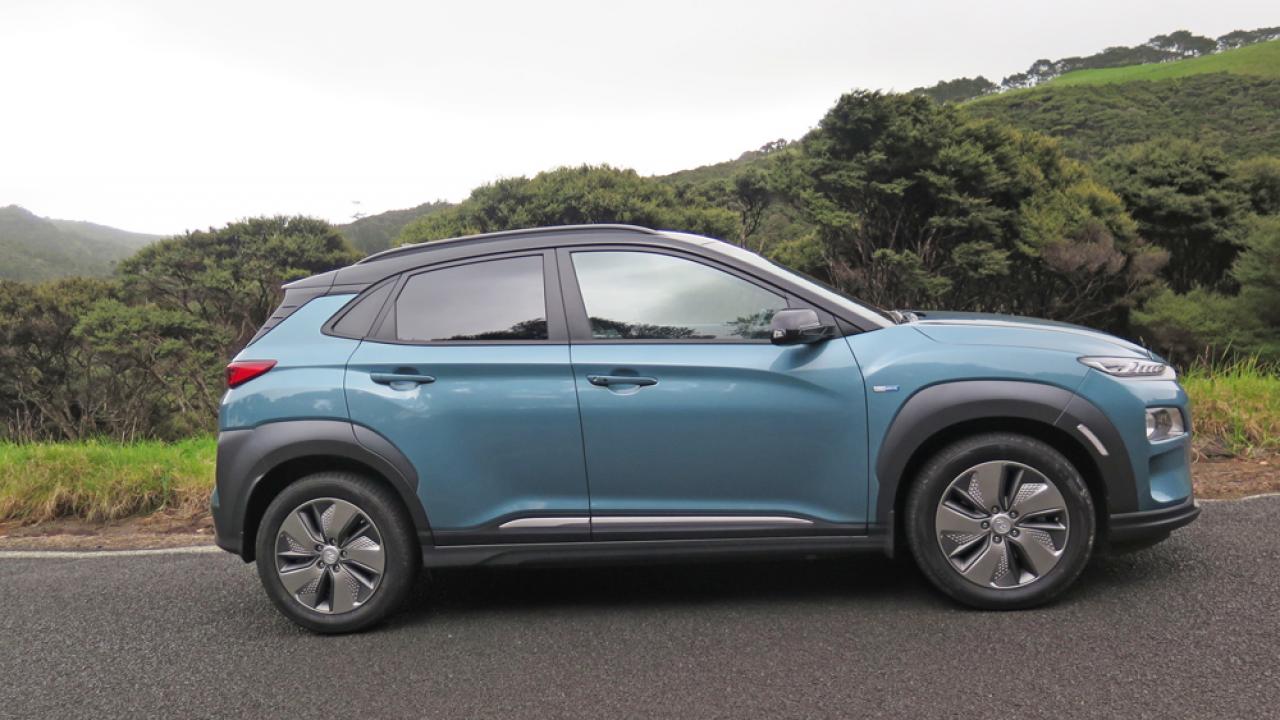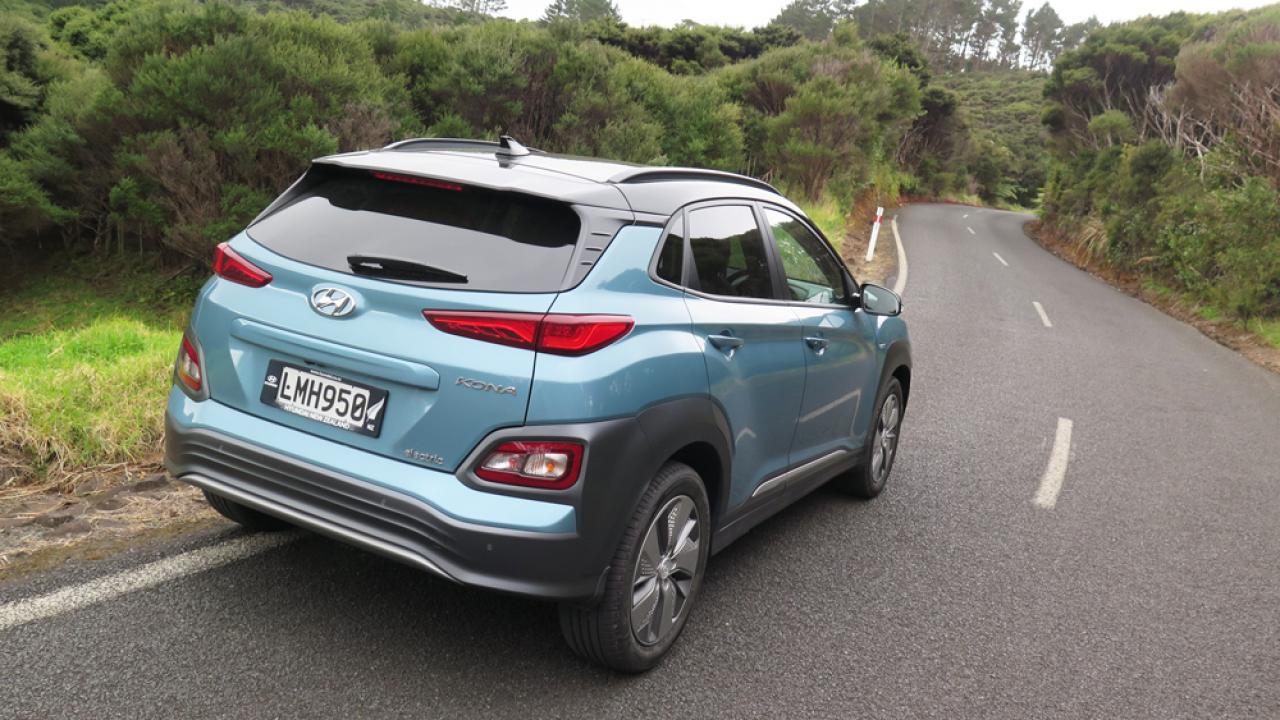There’s only one way to test the real-world usability of a vehicle like this, and that’s to use it. So we collected the Elite – the top-spec Hyundai Kona EV – ensured it was fully charged with 450km potential range showing on the clock, loaded up and headed out. So far, so normal.
The plan was to travel at the speed of the traffic in general, passing if or when it was safe to do so when we caught slower traffic, and maintaining a brisk pace through bends when appropriate.
That effectively meant the drive north was exactly the same as it would have been in any petrol-powered equivalent, with the exception that the weather was mild, the air con was virtually unnecessary, and a burst from the heated seat was all that was needed to stay comfy until dusk, when drizzle and lights added to the battery draw.
The mandatory half-way tea break allowed an app search for charging stations en route, and it turned out there were quite a few useful ones, and many more charge points than expected.
Had we needed to charge up, we would have stopped at one near a café, most likely in Whangarei, though there were options before that: however, the battery still showed plenty of oomph.
Back on the road Kona was quiet, smooth, comfy, the equipment to hand all worked as it should, there was nothing at all to indicated the car ran on anything other than conventional petrol bar, perhaps, a reduction in any vibration, and it handled as one would expect of a vehicle of this size and style.
We arrived after 237km of driving, some of it with the wipers, lights and heated seats on, with 310km range remaining. Not bad, but if we wanted to stop at the supermarket on the way home, 268km away – let alone use the car over the weekend – we’d have to charge up.
Bingo, our app showed a fast charger in Russell, at an accommodation venue.
Long story short, one was planned, but not yet in situ. However, given weekend plans included Kerikeri – with some public chargers in Paihia, and several Kerikeri already confirmed, topping up would have been a cinch, as would charging the battery during the return tea stop.
In the event, we simply plugged Kona into the household socket.
But what about that 48-hour three-pin-socket charge time? Ah, but that’s from empty to full, and assuming you need the whole range. Clearly, if you did you’d go to the nearest fast charger, just as you would to the nearest petrol station. Most folk, most of the time, will not start with an empty battery, nor need a full one. In the event we left with 380km range showing, the back seats folded, and the car packed with two heavy wooden two-drawer filing cabinets loaded, plus luggage for two for an active weekend, and some op-shop finds. Again, we passed within a block of several suitable charging stations, but opted out, had our tea break elsewhere, and got home with more than enough to spare despite intermittently using the wipers, various temperature controls, and 12V socket to charge the phone.
We then plugged into a household socket overnight – yes, the least efficient method – and topped up to over 200km by morning, then returned the car. Interestingly, given the final run’s downhills and urban crawl regenerated the battery a tad, hybrid style, potential range dropped by 15km during a drive lasting 23km …
It’s certainly easy to work out how you’re doing, if you’re so inclined. The large touch screen lets you see percentage battery fill remaining, how many kg of carbon emissions have saved over a petrol car, you can even time charging.
The weekend proved a few things. Kona is as comfortable and as useful as any other car of a similar size and focus, albeit with a generous array of comfort and safety features, as you’d expect of any high-tech car not selling on price alone, and being an EV, it’s not cheap.
We’d driven 544km of varied roads, with a higher proportion of hills than most daily drives, and a lower proportion of urban driving – so the majority of our kays were done at speeds and on roads which don’t display an EV at its best.
We had no problem with range, despite plugging in only to household supply: few folk will drive 400km a day, so most of the time you don’t need to worry about the time it’d take to charge the car up to full. On a trip exceeding 400km most folk would factor in at least one tea break, which an EV driver would take at a charging point. Only have time to charge to 80%? By around 300km of driving, a loo or another cuppa might be nice.
As for fuelling cost, we averaged 14.7kW/h per 100km, higher than if we’d stuck to low-speed roads. At our tester’s home supply rate, that’d be $4.10 per 100km, or $22.55 for our trip. A standard 2.0-litre petrol Kona’s fuel claim is 7.2l/100km. Assuming you achieve that, you’d pay $17.20 to do 100km on petrol, or $94.60 for 91-octane petrol for the same journey, priced up at our tester’s local garage and without factoring in service costs, oil and filters.
Sure, the technology isn’t cheap up front. But if you do a lot of kilometres per year – or a lot of round-town driving, which uses less power, and regenerates more – EV costs won’t have to descend far before the ownership proposition becomes a no-brainer, even without the warm fuzzies that come with emissions-free driving.
|
At a glance |
|
|
Models |
Hyundai Kona EV Elite |
|
Engine |
Permanent magnet synchronous motor |
|
Price |
$79,990 , +$750 if two-tone |
|
ANCAP safety rating |
5 Star |
|
Power and Torque |
150kW, 395Nm |
|
Transmission |
Direct Drive |
|
Range |
real world 400km |
|
Towing capacity |
No tow rating |
|
2WD/4WD/AWD |
2WD front |
|
Seating capacity |
5 |
|
Luggage capacity/payload |
332 litres all seats in use, 1114 litres, row two folded |
Safety systems
- Blind Spot Warning
- Lane Keep Assist
- Forward Collision Avoidance Assist
- High Beam Assist
- Rear Cross Traffic Alert
- Smart Cruise Control
- Lane Following Assist
- Driver Attention Alert






